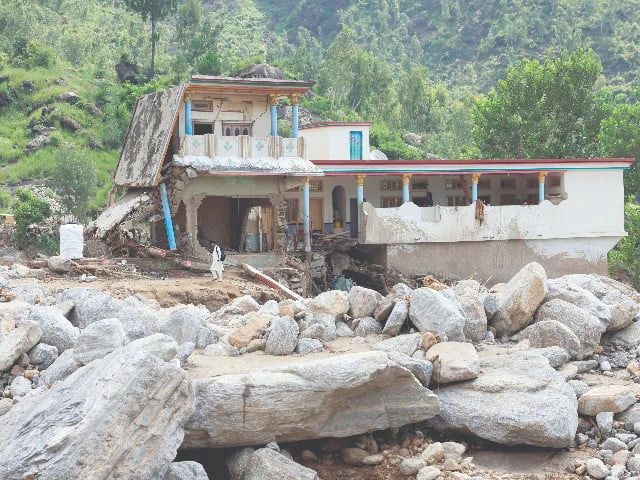Qadir Nagar:
Two days before his wedding, Noor Muhammad had a long phone call with his mother, just hours before devastating floods in Khyber-Pakhtunkhwa killed her with 23 family members and relatives.
“I can’t explain how happy she was,” he said, standing by the rubble in his family’s large 36-bedroom house, located on the shores of a flood water channel in Qadir Nagar village.
The village of mountainous Buner district has been the worst affected by the recent massive rain in the country, accounting for over 200 deaths out of nearly 400 in floods in the northwest since August 15.
Buner is a three and a half hour drive from the capital Islamabad. “Everything was done,” cried Muhammad, 25, when mourning was sitting at his damaged house to offer condolance and said there was nothing left when he came home except rubble and heavy cliffs swept down from the mountains along with mud and furious flood water that smashed into houses, markets and buildings.
“The flood came, a huge flood came, it swept everything, home, mother, sister, brother, my uncle, my grandfather and children.”
Muhammad works as a worker in Malaysia. He arrived at Islamabad Airport on August 15 to drive home, where his wedding preparations were in full swing two days later. Instead, he attended 24 funerals. They included his mother, a brother and a sister, he said, adding that his father and another brother survived because they had gone to pick him up at the airport.
The rest of the death was among his uncles’ families who shared the house built by his grandfather, and relatives who participate in his marriage. His fiancé survived. Her home was away from the worst of the damage.
Devastating flash floods
The flash floods triggered by the worst of this year’s Monsun and Cloudbursts, which started in the mountainous northwest, have spread to other parts of the country of 240 million, bringing death and destruction on a large scale.
The authorities have said that the longer spell with heavy rain and rare skybursts was rooted in climate change due to global warming, in fear that the intensity will increase in the coming years.
“We and our elders have never seen a storm like this in our lives,” said Muhammad Zeb, 28, residing in Buner. It was a complete chaos and massive disaster, he added. “You can see for yourself, this was a beautiful place with home. But now that you can see, the flood and the storm swept everything away.”
An unknown number of people remain missing where dead bodies are still recovered, officials said. The total death toll across the country in the Monsun rain, which began in late June, stood at 776, according to the National Disaster Management Authority, who said more than 25,000 people had been saved in the northwest.
The army and Air Force have joined the rescue and relief efforts. Officials have warned of several storms ahead with two more spell with monsoon rains expected until September 10.
Buner received more than 150 mm (5.91 inches) rain within an hour triggered by a cloudburst in the most destructive event of this monsoon season. A skybour is a rare phenomenon where more than 100 mm (3.9 inches) rainfall within an hour of a small area. Only four people of the 28 in his house survived, Muhammad said. “What else can we say? It’s God’s will,” he said.



